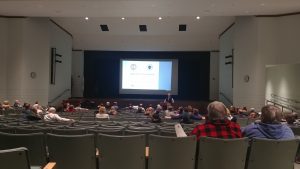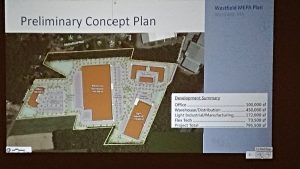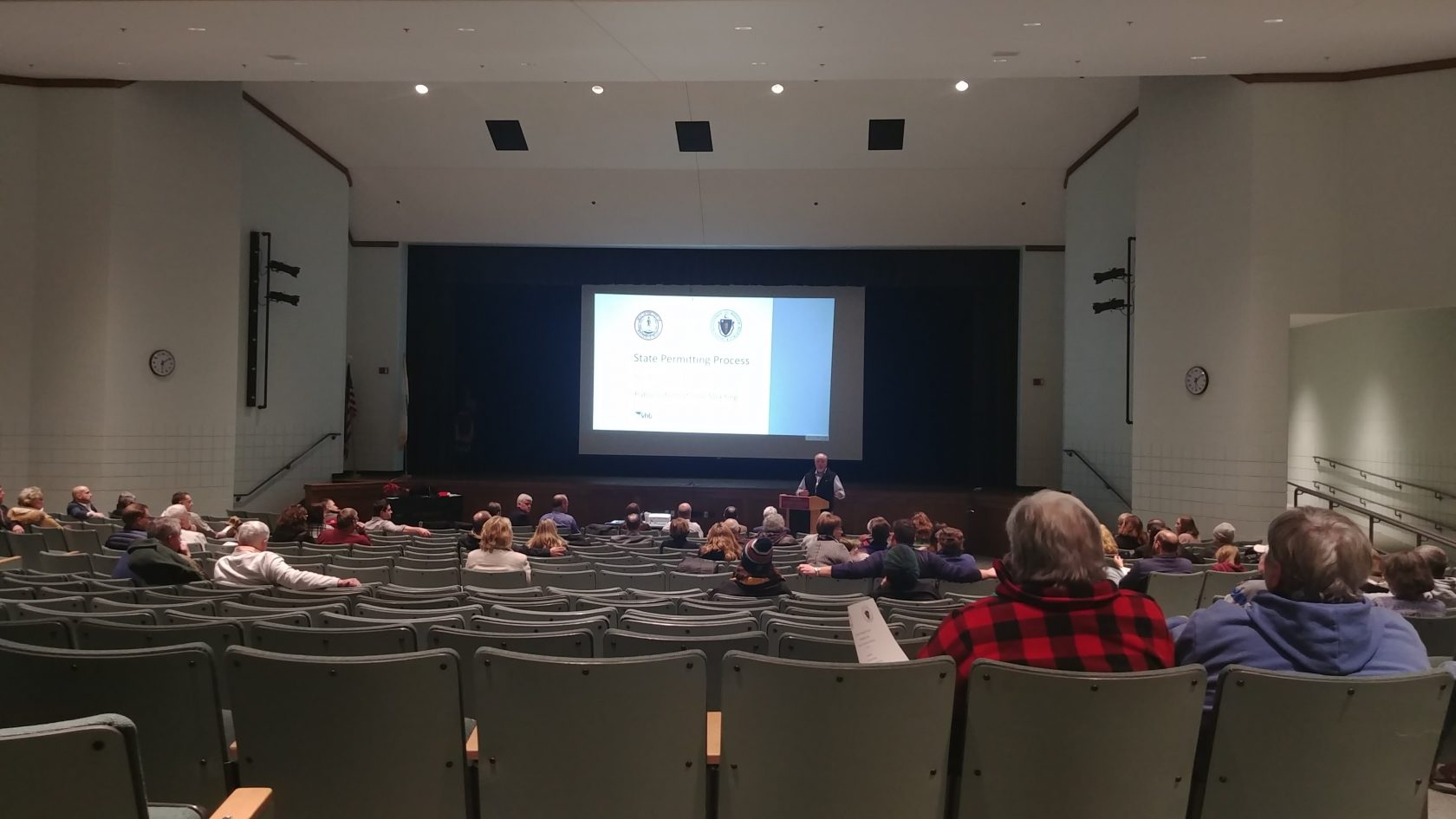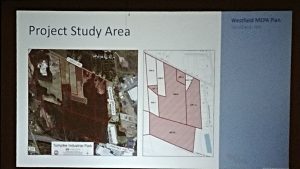WESTFIELD—Residents were provided with information about the ongoing process happening at the proposed industrial park located off Turnpike Industrial Road yesterday.
Many residents turned out for the presentation at North Middle School on Southampton Road Wednesday night. Those on hand were given an update on how the proposed industrial park, including its current status going through the Massachusetts Environmental Policy Act (MEPA) process and making the location “shovel-ready” for businesses.
It was stressed though, that it is early in that process and that the presentation was an informal meeting that was attempting to provide additional information to residents.

Residents on hand for the informational meeting on the proposed industrial park on Turnpike Industrial Road and Cabot Road.
“The purpose of this meeting is to be as open as possible,” City Advancement Officer Joe Mitchell said.
“This is just the rollout, just the beginning,” he added. “Wanted to be sure you, the citizens, were informed.”
Mitchell said that this meeting was informal, and that as the project develops, residents would be able to provide further input onto the project and its potential impacts. Among the steps would include formal meetings, Mitchell said, where residents could submit questions and minutes would be taken at the meetings.
Also, any potential suitor for one of the sites at the proposed industrial park would have to also go through the city’s permitting processes, including Planning Board and site plan approval measures.
In addition to Mitchell, Westfield Mayor Brian Sullivan spoke, along with others working on the project, including Ed Starzec, Director of Land Planning and Permitting from MassDevelopment, an economic development agency through the state, Geoffrey Morrison-Logan, Regional Director from VHB Engineering and Michael DiGiano, Vice President of NAI Hunneman, a real estate company.
The proposed industrial park will be located between Turnpike Industrial Park and Cabot Road on a total of 66 acres. The site has a tentative 150-foot buffer to the north, which goes along Sabrina Brook.
The preliminary planning for the site is about 795,500 square feet, and could include plots for office, warehouse or distribution, light industrial or manufacturing and “flex tech” businesses, according to Morrison-Logan.
The location would include parking and roads as throughways, with stormwater detention and water quality treatment areas, according to Morrison-Logan.
According to Mitchell, the land is zoned Industrial A, which is contiguous with some of the area. Other nearby zoning includes Residential A and Business A and B.
Mitchell also said that “it’s not on the Barnes Aquifer,” referring to the location of the site. He also added that it is not in the Barnes Aquifer recharge area, either.

Preliminary concept plan of the proposed industrial park on Turnpike Industrial Road and Cabot Road.
Previously, the land was purchased by the city in 1989 for use as a landfill. However, according to Mitchell, the state put a moratorium on landfills in 1994, and since, the land has sat vacant with no economic activity.
Mitchell said that the MEPA process is a long and expensive one, and that the city is going through the process to try and create a more business- or “shovel-ready” location. The city, according to Mitchell, is also “planning for all contingencies” through the process, which will help to be certain the location fits businesses and businesses fit the location.
According to the state website for the MEPA review process, it “provides meaningful opportunities for public review of potential environmental impacts of certain projects for which certain actions by state agencies are required.” This includes environmental impact studies for projects that need state permitting, among other items, and to help protect the environment.
The city last year received about $300,000 from MassDevelopment to assist with the MEPA process, which was about 25 percent of MassDevelopment’s yearly spending total, according to Starzec.
A resident later in the meeting asked about the $300,000, and it was noted by Starzec that it is a repayable grant to the city.
“We’re fronting the money until a business comes into town, at which point they pay the city, then MassDevelopment will recapture our $300,000,” he said.
However, if development does not occur, then after 30 years the money is forgiven.
Starzec said during the meeting that MassDevelopment has an “express goal of increasing inventory of large land sites in state of Massachusetts that can be served or potentially served by large utilities and road access.”
He added that, “in some ways the turnpike site is the largest site we’re working with in the Commonwealth.”
Among the items that the funds will help through the site readiness program are environmental studies, surveys and moving through the regulatory process.
According to Morrison-Logan from VHB Engineering, thus far some of the items done include determining the metes and bounds of the property, a wetlands assessment, site and infrastructure assessment, concept planning, as well as some traffic analysis.
Morrison-Logan said during the meeting that an environmental review has been initiated, and that by the summer to October there should be final environmental studies done, with certificates by November.
The tentative industrial park in Westfield would potentially be a unique site, if completed. According to DiGiano of NAI Hunneman, there is just one available manufacturing space in the city that exceeds 100,000 square feet, and no distribution sites that exceed that.
Companies are in the market for these sites however, and DiGiano said that “most economists are predicting job growth,” though it may be modest in the region.
DiGiano said that 18 sites were IDed that are 25 acres or more that could act as potential competition for the site, though 11 “would be competing head-to-head.”
DiGiano said that if the MEPA process is completed for the site, “this would be one of the few exceptional sites where that work would be done.”
According to Morrison-Logan, the project could potentially have $120 million in construction costs for businesses, with a potential for 1,100 or more permanent jobs, in addition to 800 construction jobs generated.
Also, eventually the site could generate in excess of $1 million in tax revenue, per Morrison-Logan.
Mitchell noted during the meeting, which included a question by a resident, that there may need to be additional infrastructure work for the site, including road and sewer.
If this were the case, then Mitchell said the city would apply for an additional grant to help fund it. Otherwise, the matter would have to go before City Council and into the city’s budget in an attempt to get it approved.
A resident inquired about potential impact on property values that the proposal could have. However, Mitchell noted that as the process moves forward this and other questions will also be addressed.
“All these questions are valid,” Mitchell said. “This is just the beginning, there are several other steps where you can make your voices heard.”
Resident and WRAFT member Kristen Mello also voiced concern of the location of the development, noting that while it is not within the Massachusetts Department of Environmental Protection’s “Zone II Aquifer area” it is above medium- and high-yield aquifer areas on the Geographic Information System (GIS).
Mello said that it “seems to me this particular development is antithetical to what was adopted” at the city’s recent Open Space and Recreation Committee meeting.
Ward One Councilor Mary Ann Babinski also spoke at the meeting, and among other items said that she wanted to “make sure the city listens” to resident concerns.
Two other city councilors, At-Large Councilor Matt Emmershy and Ward Three Councilor Andrew Surprise, also asked questions at the meeting.
Emmershy asked of the property values presently at the site versus after the MEPA process and what the potential difference could be.
According to DiGiano, the site could develop into $60,000 to $80,000 per acre, but could also be worth a little more.
Mayor Sullivan added that the city initially purchased the property and thus far has not had a return on investment.
“In [1989], we purchased this land for $2.3 million. Our return on investment to date is zero,” Sullivan said.
One item Surprise inquired about was sewer extension to the north side, which Sullivan noted that the business community may pay into that.
“If we’re doing our homework correctly and people are wanting this property, we aren’t going to be giving you a break coming here,” Sullivan said.







